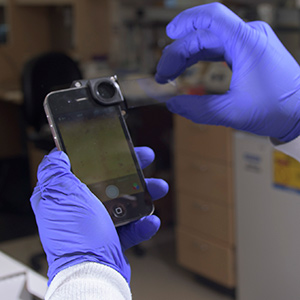 Two researchers at Massachusetts General Hospital have developed a device that can return a cancer diagnosis in an hour, without an invasive biopsy, using a smartphone.
Two researchers at Massachusetts General Hospital have developed a device that can return a cancer diagnosis in an hour, without an invasive biopsy, using a smartphone.
The D3, or digital diffraction diagnosis, system, is a small device that attaches to the smartphone's camera to convert it into a powerful microscope that can analyze a sample of a few cells, either taken from a blood sample, a fine needle biopsy, or a Pap smear. The system injects special antibodies into the sample that "light up" when they find a cancer cell.
"The smartphone picks up the shining of the antibodies when the photo is snapped. And researchers can use this signal to diagnosis a patient with cancer,” Dr. Ralph Weissleder, the team leader, told MGH's news center. “I am sure we will be able to detect other diseases too. It’s very similar to what a pathologist would actually do.”
The device has performed comparably with pathologists in two pilot studies, one in which it was tasked with determining whether cervical biopsy samples were high-risk, low-risk or benign and one in which it was tasked with distinguishing between four malignant tumors and four benign ones.
The system was originally designed to help diagnose diseases in places like remote parts of Africa, without much medical infrastructure. But Weissleder and his co-team leader, Hakho Lee, believe it has applications at home as well, obtaining fast test results for patients at a hospital or even eventually being developed into a home test.
The basic science, of sending small particles to hunt down and illuminate cancers, is reminiscent of one of the moonshot projects Google Life Sciences is currently working on. And the pitch -- smartphone-based cancer diagnosis with a handful of cells in under an hour -- harkens back to research Lee was doing back in 2011, which used a stripped down, miniaturized MRI machine, called a DMR, to analyze the sample.
The next step will be a large clinical trial in Africa, sponsored by an NIH grant.




















